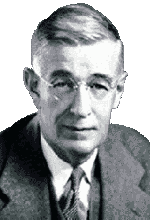
Vannevar Bush

1890-1974
Vannevar Bush was born on March 11th 1890 in Everett (some say Chelsea) MA, the son of Richard and Emma Bush. Richard Bush was a Universalist Minister and Vannevar's grandfather was the captain of a whaling ship. Vannevar was a sickly boy who was often confined to bed. However, he did very well in school and earned a half scholarship to Tufts University. In 1913 he graduated from Tufts, earning both a B.A. and an M.S.. He worked for General Electric for a short period of time, but then took a job as a mathematics instructor at Clark University (Tufts sister college). In 1914 he returned to school, earning his Ph.D. in engineering in a single year. Dr. Bush returned to Tufts as an assistant professor. During World War I Bush worked for the National Research Council on a submarine detection device. In 1916 he married Phoebe Davis. Bush moved from Tufts to MIT in 1919 to join their electrical engineering department. In 1931 Vannevar completed a differential analyzer, which he patented in 1935. This was a large mechanical analog computer which could solve differential equations. In 1937 Vannevar was made the president of the Carnegie Institution, giving him influence over the distribution of the 1.5 million dollars it awarded annually for research. Bush was made director of the National Defense Research Committee (NDRC) during the second world war. Later he headed the Office of Scientific Research and Development. In 1945 Bush published one of his more famous articles "As We May Think," in the Atlantic Monthly. After the war, Bush's call for continued funding of scientific research contributed to the eventual founding of the National Science Foundation in 1950. Bush died in 1974 after a long and highly productive life.
|
Bush's 1931 Differential Analyzer |
Wheel and Disk Integrators |
Links